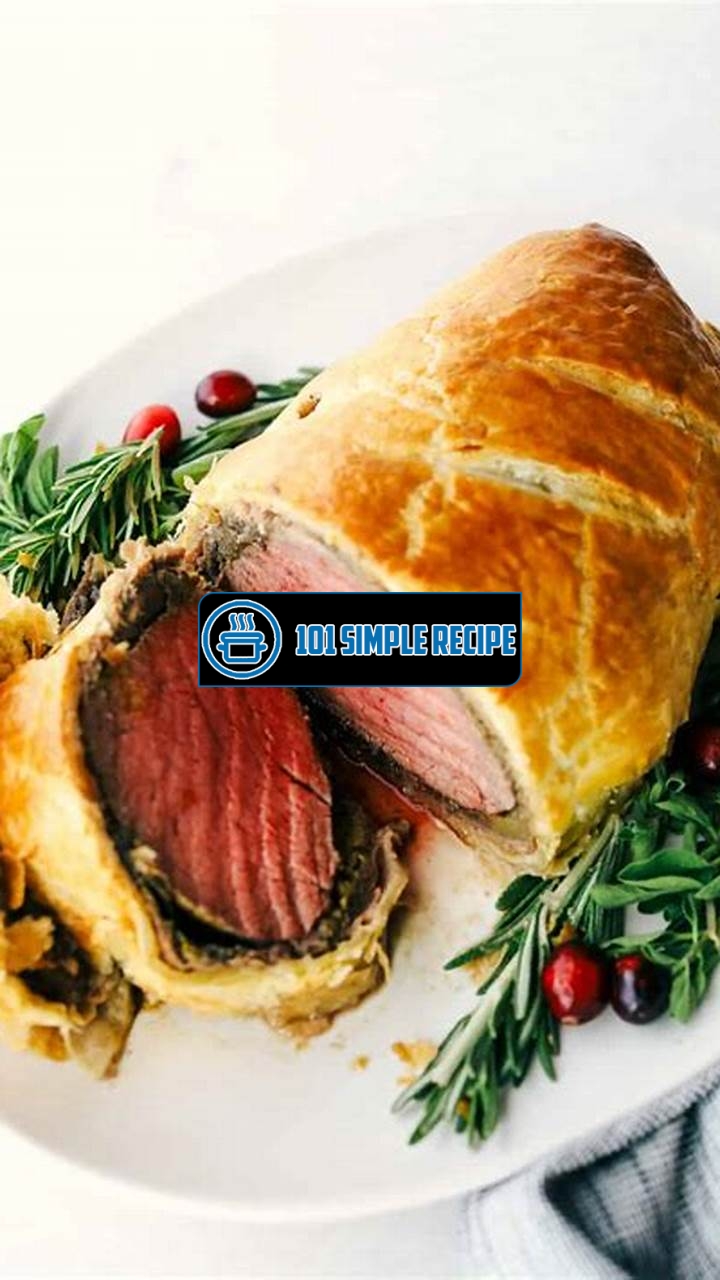Master the Art of Beef Wellington with this Recipe

You’ve always admired the elegant and mouthwatering dish called Beef Wellington, but have you ever tried to make it yourself? Now is the perfect time to take on the challenge and become a master of this culinary masterpiece. In this article, you will discover a tried and true recipe that will guide you through the steps of creating the perfect Beef Wellington. Prepare to impress your friends and family with your culinary skills as you dive into the world of rich flavors, tender beef, and a flaky pastry crust. With this recipe, you can confidently conquer the art of Beef Wellington and add a touch of sophistication to your next special occasion. So roll up your sleeves, sharpen your knives, and let’s get cooking! ️
The History of Beef Wellington
Beef Wellington is a classic dish that has captured the taste buds of food enthusiasts around the world. The origins of this delectable dish can be traced back to 19th century England. Although it is unclear who exactly created Beef Wellington, many believe it was named after Arthur Wellesley, the First Duke of Wellington.
️ The Origins of Beef Wellington ️
The Duke of Wellington was renowned for his military triumphs, and it is said that the dish was created to honor his victories. Legend has it that his chef wanted to create an impressive and extravagant dish that would match the grandeur of the Duke’s character. Thus, Beef Wellington was born.
This classic dish consists of a tender filet mignon, coated in a rich layer of savory mushroom duxelles and wrapped in puff pastry. The combination of flavors and textures creates a symphony of taste that has stood the test of time.
️ Evolution of the Recipe ️
Over the years, the recipe for Beef Wellington has evolved and adapted to suit different culinary preferences. In its early days, the dish was typically prepared in a simple and straightforward manner, with the focus on showcasing the quality of the ingredients.
As time went on, chefs began experimenting with different variations of the recipe. Some added pâté or foie gras to enhance the richness of the dish, while others incorporated truffles for a more luxurious touch. These additions elevated the flavors of Beef Wellington and made it even more indulgent.
️ Notable Variations and Adaptations ️
Today, there are countless variations of Beef Wellington that cater to different dietary preferences and cultural influences. For example, some chefs substitute the traditional filet mignon with other cuts of beef, such as ribeye or sirloin. This allows for a different flavor profile and texture.
Additionally, there are vegetarian versions of Beef Wellington, where the meat is replaced with a flavorful combination of vegetables and grains. These adaptations provide a delicious option for those who follow a plant-based diet or simply want to explore new culinary horizons.
Notable chefs and restaurants have also put their own spin on Beef Wellington. Some have added unique ingredients, such as balsamic glaze or blue cheese, to create a twist on the traditional recipe. These adaptations showcase the versatility of the dish and the creativity of the chefs behind it.
️ In Summary ️
The history of Beef Wellington is a testament to the enduring appeal of this classic dish. From its humble beginnings as a tribute to the Duke of Wellington to the myriad of variations and adaptations that exist today, Beef Wellington continues to be a beloved choice for those seeking a gourmet dining experience.
What Makes the Best Beef Wellington
When it comes to Beef Wellington, mastering the art requires careful attention to every element of the dish. From the perfect cut of meat to the right selection of mushrooms and the flakiest pastry, each component plays a crucial role in creating an exceptional Beef Wellington.
The Perfect Cut of Meat
The first step to creating the best Beef Wellington is choosing the perfect cut of meat. The ideal choice for this classic dish is a tender and well-marbled beef tenderloin. This cut, also known as filet mignon, is incredibly tender and has a melt-in-your-mouth texture that elevates the overall experience of the dish. When selecting the meat, opt for a center-cut portion, ensuring even cooking throughout.
Tip: Look for well-marbled beef tenderloin for a juicy and flavorful result.
Choosing the Right Mushrooms
Mushrooms are a key ingredient in Beef Wellington, providing a savory and earthy flavor to balance the richness of the beef. While some recipes call for button mushrooms, the best Beef Wellington often features a combination of wild mushrooms such as cremini, shiitake, and porcini. These varieties add complexity to the dish and complement the beef perfectly.
Tip: Use a mix of wild mushrooms to enhance the flavor profile of your Beef Wellington.
Once you have selected the right mushrooms, it is important to prepare them correctly. Finely chop the mushrooms and cook them in butter until they release their moisture and develop a deep, rich flavor. This step helps remove excess moisture from the mushrooms, ensuring the pastry stays crisp during baking.
Creating the Flakiest Pastry
The flaky pastry is the crowning glory of a perfect Beef Wellington. To achieve the desired texture, use a high-quality puff pastry that is light, buttery, and capable of rising beautifully in the oven. Proper handling of the pastry is crucial as well. Roll it out thinly and evenly to ensure even cooking and a crisp, golden crust.
Tip: Invest in a high-quality puff pastry for a truly exquisite Beef Wellington.
Additionally, when assembling the Beef Wellington, it is essential to wrap the pastry around the meat securely, sealing in the flavors and moisture. This step not only enhances the presentation but also locks in the juices, resulting in a tender and succulent filling.
Mastering the art of Beef Wellington requires attention to detail at every step. From selecting the perfect cut of beef to choosing the right mushrooms and creating a flaky pastry, these key elements contribute to the exceptional taste and presentation of this classic dish. With these tips in mind, you can elevate your Beef Wellington to new heights and impress your guests with a culinary masterpiece.
Mastering the Cooking Techniques
In order to create the best Beef Wellington, it’s important to master the cooking techniques involved. This delectable dish requires precision and careful attention to detail. By following these step-by-step instructions, you can create a Beef Wellington that will impress even the most discerning palate. Let’s dive into the process and explore each cooking technique:
Preparing the Beef Fillet
The first step in mastering the art of Beef Wellington is preparing the beef fillet. This is the star of the dish, so it’s crucial to choose high-quality meat. Look for a tenderloin cut, as it will result in a melt-in-your-mouth experience. Tenderize and season the fillet with your favorite spices, such as salt, pepper, and garlic powder. This will enhance the flavor and create a delicious crust once cooked.
Next, sear the fillet in a hot skillet to lock in the juices and create a beautiful caramelized exterior. Cooking time may vary depending on your desired level of doneness. Remove the fillet from the skillet and allow it to rest while you prepare the other components.
Sautéing the Mushrooms
One of the key components of a Beef Wellington is the mushroom duxelles. This mixture of finely chopped mushrooms, onions, garlic, and herbs adds depth and flavor to the dish. To sauté the mushrooms, heat a skillet with some butter or oil over medium heat. Add the finely chopped mushrooms and cook until they release their moisture and become golden brown. This process infuses the mushrooms with a rich, savory taste that pairs perfectly with the beef.
Season the sautéed mushrooms with salt and pepper, and let them cool before assembling the Wellington. This step ensures that the mushrooms don’t become too watery and compromise the integrity of the pastry crust.
Assembling and Baking the Wellington
Now comes the fun part – assembling and baking the Beef Wellington. Begin by rolling out a sheet of puff pastry into a rectangular shape. Spread a thin layer of pâté or foie gras over the pastry. This adds an indulgent richness to the dish and helps keep the beef moist during baking. Place the rested and seared beef fillet on top of the spread, and then surround it with a generous layer of sautéed mushrooms.
Carefully wrap the puff pastry around the beef and mushrooms, making sure to seal all edges. This will create a beautiful golden crust once baked. Brush the pastry with an egg wash for a glossy finish and to help the pastry adhere properly.
Preheat your oven to the recommended temperature and bake the Wellington until the pastry becomes golden brown and crispy. The cooking time may vary depending on the size of your fillet and desired level of doneness. Remember to let the Wellington rest for a few minutes before slicing, allowing the flavors to meld together.
By mastering these cooking techniques, you can create the best Beef Wellington that will leave your guests impressed and satisfied. With its tender beef, flavorful mushrooms, and flaky pastry, this dish is sure to become a favorite in your culinary repertoire.
The Art of Sauces and Accompaniments
Enhance the flavors of your Beef Wellington with delicious sauces and complementary side dishes.
Classic Red Wine Sauce
To truly master the art of Beef Wellington, it is essential to pair it with the perfect sauce. The classic red wine sauce is a timeless choice that complements the rich flavors of the dish. This velvety sauce adds a depth of flavor and elevates the dining experience.
To create the classic red wine sauce, start by reducing a good quality red wine in a saucepan over medium heat. Allow the wine to simmer until it reduces by half. This concentrates the flavors and creates a robust base for the sauce. Next, add beef or veal stock and continue to simmer for about 15 minutes, allowing the flavors to meld together.
Once the sauce has reduced slightly, strain it to remove any impurities and return it to the heat. Whisk in cold butter, one tablespoon at a time, until the sauce thickens and becomes glossy. This technique, known as mounting, adds a luxurious texture to the sauce.
Finally, season the sauce with salt and pepper to taste. The classic red wine sauce is now ready to be served alongside your Beef Wellington. The rich and savory flavors of the sauce will perfectly complement the tender beef and flaky pastry, creating a harmonious and memorable culinary experience.
Alternative Sauce Options
If you’re looking to add a twist to your Beef Wellington, consider trying alternative sauce options. These sauces can bring unique flavors and enhance the overall taste profile of the dish.
1. Mushroom Sauce: This earthy sauce can be made by sautéing mushrooms in butter and then combining them with a velvety cream sauce. The deep umami flavors of mushrooms pair beautifully with the beef and add a luxurious touch to the dish.
2. Peppercorn Sauce: For those who enjoy a bit of spice, a peppercorn sauce is an excellent choice. This sauce combines the heat of black peppercorns with cream and a touch of brandy or cognac. The peppery kick complements the richness of the beef.
3. Hollandaise Sauce: This classic sauce made from egg yolks, butter, and lemon juice adds a luscious and tangy element to the Beef Wellington. Its creamy texture and citrusy flavors create a delightful contrast to the savory flavors of the dish.
Recommended Side Dishes
A delicious Beef Wellington deserves equally delectable side dishes to complete the meal. Consider adding the following options to your menu:
- Roasted Root Vegetables: Roasting a medley of carrots, parsnips, and potatoes with herbs and olive oil adds a rustic touch to the meal. The natural sweetness of the roasted vegetables complements the savory beef.
- Sautéed Green Beans: Fresh green beans lightly sautéed in garlic butter provide a vibrant and crisp element to the plate. They also add a pop of color, making the dish visually appealing.
- Truffle Mashed Potatoes: Elevate your classic mashed potatoes by adding truffle oil or truffle butter. The luxurious and earthy flavors of truffles enhance the overall dining experience.
- Buttered Asparagus: Tender asparagus spears lightly brushed with melted butter make for a simple yet elegant side dish. Their mild flavors complement the richness of the Beef Wellington.
Pairing your Beef Wellington with the right sauce and side dishes can take it to new heights in terms of flavor and presentation. Experiment with different sauces and accompaniments to find your personal favorite combination. Remember, the key is to enhance the flavors of the main dish while adding variety and balance to the overall meal.
With these sauce and side dish recommendations, you’re well on your way to mastering the art of Beef Wellington. Elevate your culinary skills and create a memorable dining experience that will impress your guests or simply treat yourself to a gourmet meal at home. Enjoy! ️
Impressing Guests with Presentation
When it comes to serving Beef Wellington, presentation is everything. The visual appeal of this classic dish can elevate any dining experience and leave a lasting impression on your guests. In this section, we will explore creative plating and garnishing techniques that will take your Beef Wellington to the next level.
Decorative Pastry Designs
One way to make your Beef Wellington visually stunning is by incorporating decorative pastry designs. Instead of simply wrapping the puff pastry around the beef, consider adding intricate details that will wow your guests. You can create beautiful lattice patterns or use cookie cutters to make shapes out of the pastry.
- Try creating a lattice design on top of the pastry to showcase your culinary skills.
- Use leaf-shaped cookie cutters to add a touch of nature to your presentation.
- Experiment with different shapes and designs to find the one that suits your style.
Garnishing with Fresh Herbs
Garnishing is another essential element to consider when plating your Beef Wellington. Fresh herbs not only add an aromatic fragrance but also bring vibrant colors and textures to the dish. Here are a few herb garnishing ideas to inspire you:
- Sprinkle a handful of chopped parsley over the Wellington to add a pop of green.
- ️ Garnish with a sprinkle of finely chopped chili for a hint of spice.
- Use sprigs of rosemary or thyme to add an elegant touch to the presentation.
Plate Presentation Tips
Once you have finalized your pastry design and garnishes, it’s time to focus on the overall plate presentation. Here are some tips to ensure your Beef Wellington looks as good as it tastes:
- ✨ Use a clean and white plate as a canvas to highlight the vibrant colors of the dish.
- Cut the Wellington into thick slices to showcase the perfectly cooked meat inside.
- Pair your Beef Wellington with complementary sides and sauces for a complete meal.
- Add a final touch by drizzling sauce or jus around the plate for an elegant finishing.
In conclusion, mastering the art of Beef Wellington goes beyond the cooking process. The way you present this dish can make all the difference in impressing your guests. By incorporating creative pastry designs, garnishing with fresh herbs, and paying attention to plate presentation, you can elevate your Beef Wellington into a true masterpiece. So, don’t be afraid to let your creativity shine in the kitchen and delight your guests with a visually stunning Beef Wellington.
Thank you for reading our article on the best beef Wellington recipe! We hope you found this guide informative and inspiring to create your own delicious beef Wellington. If you have any questions or feedback, please feel free to leave a comment below. Don’t forget to bookmark our website and visit again for more mouthwatering recipes and cooking tips. Happy cooking!
Frequently Asked Questions
Here are some frequently asked questions about beef Wellington:
| No. | Questions | Answers |
|---|---|---|
| 1. | What is beef Wellington? | Beef Wellington is a classic British dish that consists of a tender beef fillet coated with pâté and duxelles (a mixture of finely chopped mushrooms, onions, and herbs), wrapped in puff pastry, and baked until golden and crispy. |
| 2. | Can I use a different cut of beef? | While the traditional beef Wellington uses filet mignon, you can use other cuts of beef such as tenderloin or sirloin if you prefer. Just make sure to adjust the cooking time accordingly. |
| 3. | How can I make the puff pastry from scratch? | To make puff pastry from scratch, you will need butter, flour, salt, and cold water. There are many online tutorials and recipes available that provide step-by-step instructions on making homemade puff pastry. |
| 4. | Can I prepare beef Wellington in advance? | Yes, you can prepare beef Wellington up to a day in advance. Simply wrap it tightly in plastic wrap and refrigerate until ready to bake. Make sure to brush the pastry with egg wash just before baking for a golden finish. |
| 5. | What are some suggested side dishes to serve with beef Wellington? | Some popular side dishes that pair well with beef Wellington include roasted potatoes, steamed vegetables, mashed potatoes, and a fresh green salad. You can also serve it with a red wine sauce or mushroom sauce for added flavor. |
| 6. | How can I achieve a perfectly cooked beef Wellington? | To achieve a perfectly cooked beef Wellington, it’s crucial to monitor the internal temperature of the beef with a meat thermometer. For medium-rare, the internal temperature should reach around 135°F (57°C). Let the Wellington rest for a few minutes before slicing and serving. |
Come Back for More Culinary Delights!
We hope you enjoyed exploring the best beef Wellington recipe with us. Don’t forget to come back for more tantalizing recipes and cooking inspiration. Whether you’re a seasoned chef or a beginner in the kitchen, our website is your go-to resource for all things gastronomic. Stay tuned for our upcoming articles on delectable desserts, savory mains, and everything in between. Happy cooking!
Jump to Recipe
Best Beef Wellington Recipe

Discover the best beef Wellington recipe that will elevate your culinary skills to new heights. This classic British dish features tender beef fillet wrapped in flavorful pâté and duxelles, all enveloped in buttery puff pastry. Follow our step-by-step instructions to create a showstopping masterpiece for your next special occasion.
- 1 2-pound beef tenderloin
- 1 tablespoon olive oil
- Salt and pepper to taste
- ½ cup pâté of your choice
- 8 ounces mushrooms (finely chopped)
- 1 shallot (minced)
- 1 clove garlic (minced)
- 2 tablespoons butter
- 2 sheets puff pastry (thawed)
- 1 egg (beaten)
- Preheat the oven to 400°F (200°C). Season the beef tenderloin with salt and pepper. Heat the olive oil in a large skillet over high heat and sear the beef on all sides until browned. Transfer the beef to a cutting board and let it cool.
- In the same skillet, melt butter over medium heat. Add the minced shallot and garlic, and sauté until fragrant. Add the chopped mushrooms and cook until they release their liquid and become golden brown. Remove from heat and let it cool.
- Roll out the puff pastry sheets on a floured surface and place one sheet on a baking sheet. Spread a layer of pâté on top of the pastry sheet, leaving a border around the edges. Place the seared beef in the center and cover it with the mushroom duxelles. Brush the edges of the pastry with beaten egg. Place the second sheet of puff pastry on top and seal the edges by pressing them together.
- Brush the entire Wellington with beaten egg for a golden finish. Use a sharp knife to make a few small vents on top of the pastry to allow steam to escape. Bake in the preheated oven for about 30-35 minutes, or until the pastry is puffed and golden brown. Let the beef Wellington rest for 10 minutes before slicing and serving.
- Slice the beef Wellington into thick portions and serve it on warm plates. Pair it with your favorite side dishes, such as roasted potatoes and steamed vegetables. Enjoy this culinary masterpiece with your loved ones!
- For a medium-rare beef Wellington, the internal temperature should reach around 135°F (57°C). Adjust the cooking time accordingly for different levels of doneness.






